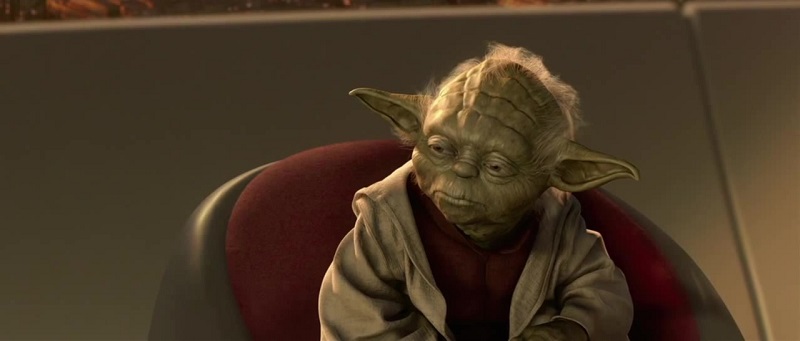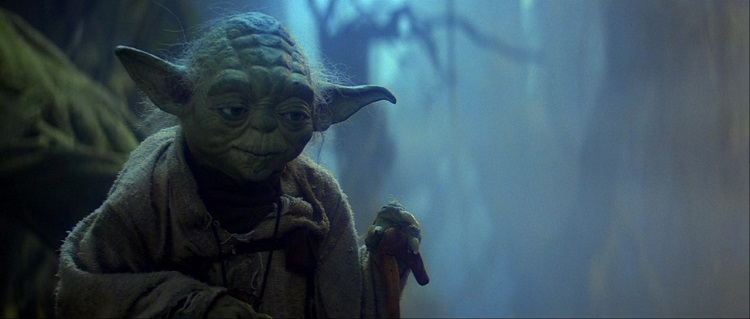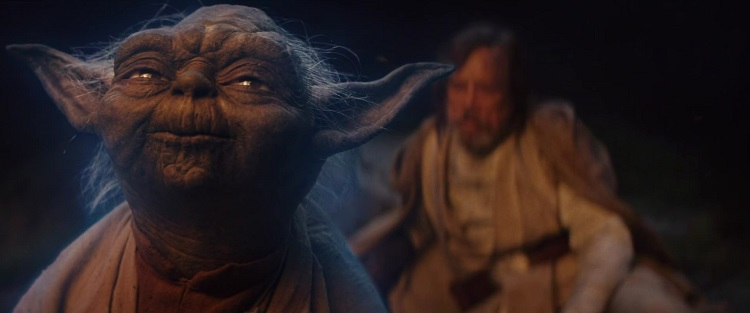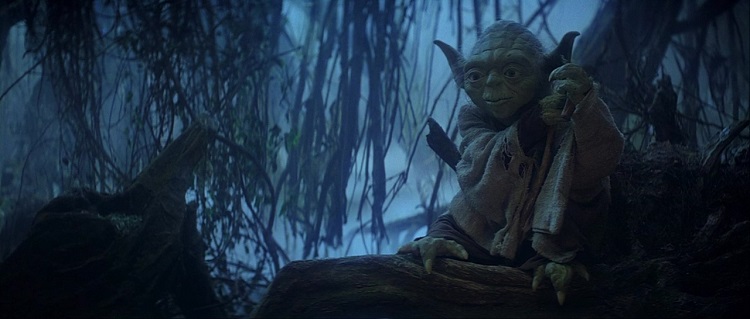Of the Star Wars characters who have been fortunate enough to appear in all three trilogies of the Skywalker saga, Yoda’s is perhaps one of the most patchwork – largely a supporting role, an invention to fill the void after Obi-Wan Kenobi’s not-entirely-planned demise in the original Star Wars. Yoda briefly took center stage as a major character in the operatic, apocalyptic Revenge of the Sith, and made a somewhat unexpected return to the series as a ghost in The Last Jedi. He may return yet again for The Rise of Skywalker, but even without that final installment Yoda’s story has perhaps by accident become one of the most poignant and illuminating that the cornucopia of Star Wars has to offer. It sees him on both ends of the spectrum of galactic power, but beyond that it tells a story of an individual’s battle with dogma and orthodoxy, and ultimately the selflessness to be surpassed by his greatest pupil.
Enter the bureaucrat
Contrary perhaps to expectations prior to the 1999 release of The Phantom Menace, when Yoda’s backstory during the time of Anakin Skywalker was unveiled he was shown to be in a drastically different milieu to that of his humble existence of Dagobah. We see that he was in fact a member of the Jedi High Council, residing on Coruscant, the capital of the Republic, in a gleaming, imposing temple with his fellow masters. He is, quite notably, not a very fun character in this environment – a naysayer in The Phantom Menace, like his colleague Mace Windu he urges caution against training Anakin.
This is not the limit of Yoda’s influence in his first chronological appearance, however – he is involved in the politics that underpin the film. This, ultimately, is of more relevance to Yoda’s story in the prequel trilogy, which escalates in the second film, Attack of the Clones. Perhaps one of the most pivotal scenes of the trilogy occurs when Obi-Wan Kenobi contacts Yoda and Mace to inform them of his discovery on Kamino of a clone army for the Republic. Processing this information, Yoda despairs that the ascendancy of the dark side has effectively rendered the Jedi blind, if they could have been so easily and completely deceived for a decade. Mace suggests that they inform the Senate that they are unable to operate to the best of their ability, but Yoda vetoes this decision. It is perhaps a throwaway hypothetical, but one can imagine that Yoda does not trust the system within which he works enough to be transparent. This plays into the hands of the Sith, creating a hermetic culture of secrets and ignored incompetence. There is a vital arrogance too: the Jedi do not humor the idea that Count Dooku has fallen to the dark side until it is far too late.

A hallmark of middle installments of Star Wars trilogies is that our heroes are going to make mistakes, but perhaps few could be as critical as the ones made by Yoda and his fellow Jedi during Attack of the Clones. Coupled with Count Dooku’s later lampshading of Darth Sidious’s conspiracy to Obi-Wan Kenobi, the characters are presented with information that suggests that the path of inevitability before them is not the one to take. But this is Star Wars, and these are Jedi, and action is always the best path. This is Lucas subverting the accepted truths of Star Wars far more totally and dramatically than Rian Johnson ever did – here is Yoda, the wise and gentle hermit being too proud to admit fault, and rushing to take action in claiming the clones from Kamino, thereby springing the trap that will extinguish the Order he is responsible for. Here is “wars not make one great” Yoda barreling the galaxy into bloody and total conflict.
By the time he and Mace decide to play games of intrigue with Supreme Chancellor Palpatine in Revenge of the Sith, it is naturally too late. Now a general in the Grand Army of the Republic, the remit of a Jedi as a tool of the senate has calcified, and the fox in the henhouse of Anakin Skywalker as a Jedi Council member is the beginning of the end. Even though Palpatine and his chokehold on the chancery is the prime concern of Yoda, Windu and Kenobi, the Grand Master is nevertheless still locked into the perfunctory dejarik moves of the Clone Wars, allowing himself to be drawn away to Kashyyyk. It isn’t necessarily a knock on Yoda that he trusts his friends to handle the Coruscant skulduggery, but it does speak to his gross underestimation of the problem at hand, and the skill of his enemy.
Even when the devil shows his face in the form of Darth Sidious, Yoda’s solution is again direct confrontation, a wizards’ duel that yields no result. The hard-nosed attitude that gave a troubled Anakin Skywalker no comfort days prior rears its head again, pulling rank and pitting Kenobi against his fallen brother – another decision that would have terrible repercussions on a galactic scale. The best thing that can be said for Yoda as Grand Master is he knows when he’s licked, self-imposing his exile to Dagobah and retreating into a new study of the Force, under the tutelage of the not-quite-ghostly presence of Qui-Gon Jinn.
Life during wartime
It would have been nice had Yoda’s landing on Dagobah survived into Revenge of the Sith‘s final cut, but one those happy accidents of Star Wars’ convoluted production sequence can yield something of a shock when we see Yoda “again” in The Empire Strikes Back – physically limited by being a puppet, the character is cheeky, impish, perhaps deranged. With the added context of the prequels, it can feel like the toll of the past events weighing on the Jedi Master combined with his new surroundings have prompted this change, but once he reveals his identity to Luke Skywalker much of the stern Grand Master returns, as well as the refrain of concern that the pupil-to-be is too old to begin training as a Jedi.

The philosophies espoused by Yoda now, however, have evolved. He preaches a path of calmness, wisdom, cautioning that the Force is to be used for “knowledge and defense, never for attack.” He is indeed the great warrior that Luke expects, but Luke is not to know that. Notably we don’t see Yoda training Luke in the ways of the lightsaber – the one time it is used on Dagobah, the master instructs his stubborn pupil to leave it behind. Yoda has lived the experience of the cave, of your enemy possessing that which you wield in confrontation, and those battles hinging on something as mundane as who is more powerful, or who is a better fencer. Both of Yoda’s adversaries in the prequels are ultimately slain by Anakin Skywalker in fits of emotional outburst, something Yoda himself would never stoop to.
Even so, Yoda and the spirit of Kenobi cannot find any solution to the galaxy’s predicament that is not violent confrontation, when it comes to the ascendancy of Luke Skywalker as a Jedi. Even when Luke, like Obi-Wan before him, rejects the notion, it is pressed harder by the dying Yoda. Even in exile, in a state of greater enlightenment, Yoda cannot find a way to influence events beyond tutelage. Perhaps that is enough – it is what he is best at and as we have seen time and time again in Star Wars, when in crisis characters revert to form. And perhaps this is where the character cannot escape his original concept, devised by Lucas as a guru and a teacher but not a “Jedi” in the classic sense.
The discreet charm of obsolescence
The confrontation demanded by Yoda and Kenobi ultimately yields the redemption of Anakin Skywalker, the death (“death”) of Darth Sidious and the return of the Jedi. It is supposedly the closing of a chapter of conflict between the diametrically opposed Jedi and Sith opened thirty-odd years earlier during the Naboo crisis. It is not, however, the end of the conflict between light and dark, and Luke suffers the same fate as his masters: his Jedi apprentices butchered by his great hope for the future, this time Ben Solo. Luke’s conclusion that the time of the Jedi is at an end and any attempt to revive them is to be aborted does not prompt Yoda’s re-appearance – perhaps silence from beyond betokens consent, and certainly Force ghosts have let their feelings be known when the mood takes them.
Yoda is roused from his silence by something more fundamentally disturbing: Luke’s refusal to take active part in the conflict, to stand against Snoke’s ascendant First Order. The same boy who rushed off to save his friends in spite of Yoda’s warning, who faced down the Emperor and Vader at once, the boy who does things and wins is instead wrapped up in the failure of the dogma he has poured himself into reviving. This will not stand. One final lesson must be imparted.

This is a different lesson for Yoda however. He knows that the dogmas have failed, and that the idea of “pacifist knights” is a contradiction in terms. He knows that the Jedi’s adherence to action, to being “keepers of the peace”, has been their undoing. And yet, what the answer is, Yoda does not know. He just knows that there is something. For the guru, the all-knowing Yoda, to not have that answer is staggering. And this is not just him being wrong about Vader, this is Yoda knowing that he doesn’t know. It is a beautiful conclusion to an epic and in some ways tragic tale for the old Jedi Master, and his final lesson for Luke provides the coda: “we are what they grow beyond.” A lesson for Luke to stop looking for frailties in Rey that aren’t there, and for Luke himself to be better than Yoda, to not simply die in isolation, not having been there for (perhaps) the final battle.
The ingenuity of Luke’s nonviolent gambit on Crait could only have come from an apprentice of the post-Order 66 “broken” Yoda. It is an embodiment of everything Yoda preached on Dagobah, and the antithesis of the classic Jedi response. Perhaps Rey and the Resistance (and a good chunk of the audience) might have wanted something akin to Yoda’s effortless dispatch of clone troopers in Revenge of the Sith, what with the beheading and the stabbing and the throwing of a lightsaber. Perhaps they wanted to see Luke turn Kylo Ren into a Hux-style piñata. But then perhaps we wouldn’t see the slaves of Canto Bight retelling the tale of Luke’s stand with breathless wonder. And that is something new as well: the Jedi are usually referred to by those not strong with the Force with either fear or skepticism, except perhaps for another child slave on Tatooine long ago. The reality of the Jedi that awaited that boy would leave the galaxy in ruins…but maybe the reality that the Canto Bight slaves will one day see could change the future. For Yoda, who has seen it all, surely nothing could be better.

